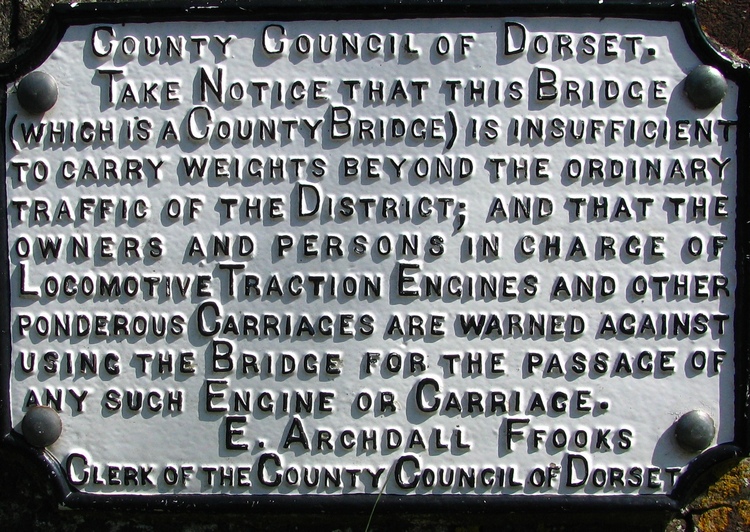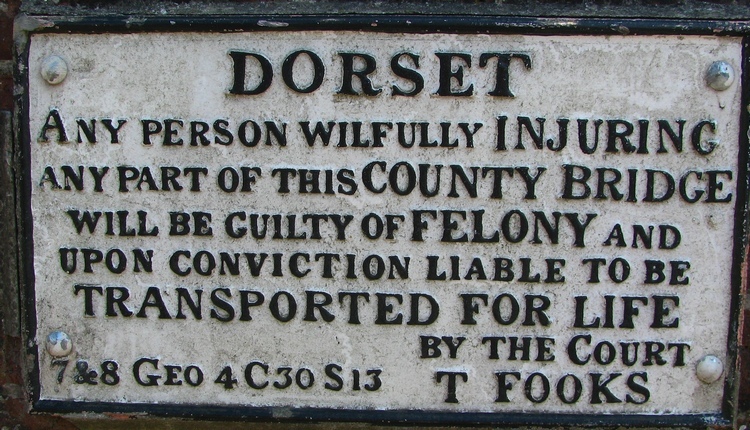
Mellstock Bridge and Farmer Shiner's. Commentary by Philip V. Allingham 2014. [You may use this image without prior permission for any scholarly or educational purpose as long as you (1) credit the photographer and (2) link your document to this URL in a web document or cite the Victorian Web in a print one.]
The transparency covering the photo in the 1920 edition has the following text: “The Mellstock Bridge and Farmer Shiner's House. (The Bridge and Riverside House, Lower Bockhampton) Farmer Shiner's is one of the houses visited by the choir, and its prototype may be discovered in the house standing above the bridge at the bottom of the village of Lower Bockhampton, nowadays more enclosed than formerly. The choir, after leaving Farmer Shiner's, crossed Mellstock Bridge, going 'along an embowered path beside the Froom towards the church and vicarage.”
Commentary
The reader encounters the prosperous curmudgeon Farmer Siner (originally "Shinar") as the village "quire" members make their rounds caroling on Christmas Eve. Whereas the previous households visited have welcomed the musicians with warm greeting, praise, and good cheer, the farmer scowls at the carolers from his bedroom window on the second story:
Farmer Shiner's was a queer lump of a house, standing at the corner of a lane that ran into the principal thoroughfare. The upper windows were much wider than they were high, and this feature, together with a broad bay-window where the door might have been expected, gave it by day the aspect of a human countenance turned askance, and wearing a sly and wicked leer. Tonight nothing was visible but the outline of the roof upon the sky. . . . .
They [the assembled musicians] had reached the end of the second verse, and the fiddlers were doing the up bow-stroke previously to pouring forth the opening chord of the third verse, when, without a light appearing or any signal being given a roaring voice exclaimed —
'Shut up, woll 'ee! Don't make your blaring row here! A feller wi' a headache enough to split his skull likes a quiet night!'
Slam went the window. [Part the First, "Winter," Chapter Five, "The Listeners."]
Sarah Bird Wright notes that, perhaps based on this incident, Farmer Shiner incites Parson Maybold to replace the Mellstock "Quire" with an organ, to be played by their mutual love-interest, Fancy Day.
The bridge at Lower Bockhampton bears two interesting "warning" signs dating from the early nineteenth century. The first has to do with the load the bridge will sustain, the second with the punishment that will be visited upon vandals:


[Click on these images for larger pictures.]
Bibliography
"Frontispiece." Under The Greenwood Tree or The Mellstock Quire — A Rural Painting of the Dutch School by Thomas Hardy. The Anniversary Edition. New York and London: Harper & Brothers, n. d. [1920]. Vol. 7.
Pinion, F. B. A Hardy Companion: A Guide to the Works of Thomas Hardy and Their Background. Trowbridge, Wiltshire, and Basingstoke: Macmillan, 1968, rpt. 1984.
Wright, Sarah Bird. Thomas Hardy A to Z: The Essential Reference to His Life and Work. New York: Facts On File, 2002.
Last modified 19 April 2024